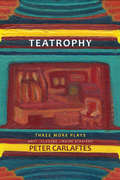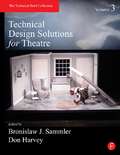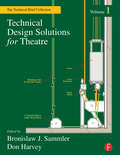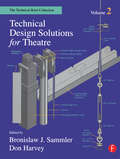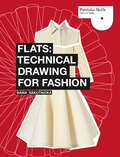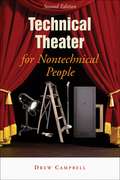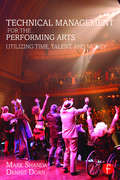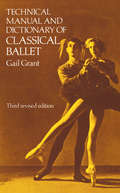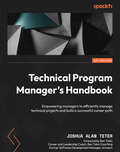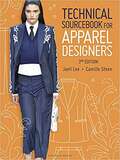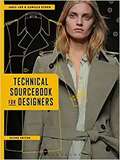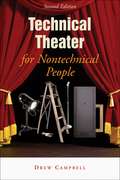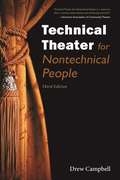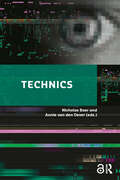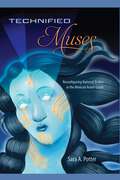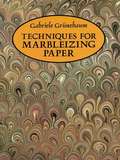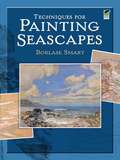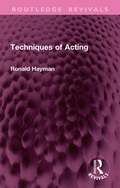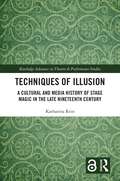- Table View
- List View
Teatrophy
by Peter CarlaftesIn Teatrophy: Three More Plays, critically-acclaimed playwright/author/poet Peter Carlaftes offers a trio of brilliant and intense modern plays that inspire on both page and stage. In "Anti,” Carlaftes explores a frightening future-in which government surveillance and data mining is the norm-through the eyes of a theater director on the verge of giving up hope. The chilling psycho-sexual drama "Closure” examines the relationship between a woman whose sister was abused a child, and the rapist-murderer that stalks her outside her therapist’s office. In the tender and humorous "Inside Straight,” characters must confront their lovers’ sudden shift in sexual orientation as a gay man and a lesbian woman discover they are attracted to each other. The San Francisco Bay Guardian praised the play: "Inside Straight is a comedy of eros! . . . A restive heart knows no logic or permanence. ” All three plays share a passion for beautifully drawn, full characters and powerful moments that force them to expose the true identity they work so hard to hide. As the SF Weekly raved, "As with Strindberg, Beckett or even Sartre, Carlaftes’ message seems to be something we intuit, like music. ”
Tech Tools for Improving Student Literacy
by Hilarie B. Davis Bradford T. DaveyTechnology isn’t just fun to use in the classroom, it can also make real improvements in students’ literacy development. In this book, authors Hilarie Davis and Bradford Davey show you how and why to use tech tools to help enhance the teaching of reading, writing, speaking, listening, and viewing. These tools can be used in English/Language Arts and across the subject areas to promote literacy throughout your school. Special Features: Practical classroom examples from a variety of content areas Connections to specific Common Core State Standards "Using the Technology" boxes with step-by-step guidance on using a tool Screenshots that show how the tools work Strategies to help you use the tools effectively with students
Technical Design Solutions for Theatre Volume 3: The Technical Brief Collection Volume 1
by Bronislaw J Sammler Don HarveyTechnical Design Solutions for Theatre is a collection of single-focus articles detailing technical production solutions that have appeared in The Technical Brief Collection, a publication of the Yale School of Drama’s Technical Design and Production Department. The primary objective of the publication was to share creative solutions to technical problems so that fellow theatre technicians can avoid having to reinvent the wheel with each new challenge. The range of topics includes scenery, props, painting, projections, sound, and costumes. Each article describes an approach, device, or technique that has been tested onstage or in a shop. Great reference of tips and solutions to persistent technical challenges in theatre production Solutions provided by contributors from over twenty different producing organizations Ten years of The Technical Brief Collection articles bound in each of three volumes A comprehensive index to all three volumes included in Volume III
Technical Design Solutions for Theatre: The Technical Brief Collection Volume 1
by Don Harvey Bronislaw J. SammlerThe Technical Brief is a collection of single-focus articles on technical production solutions, published three times a year by the prestigious Yale School of Drama. The primary objective of the publication is to share creative solutions to technical problems so that fellow theatre technicians can avoid having to reinvent the wheel with each new challenge. The range of topics includes scenery, props, painting, electrics, sound, and costumes. The articles each describe an approach, device, or technique that has been tested on stage or in a shop by students and professionals. Some articles included: Growing Flowers on Stage; Break-Away Glass; Photo-Murals for the Stage; Quiet Wire-Rope Curtain Track; Free Standing Curved Stairs; A Measured Approach to Kerfing; A Low-Voltage Remote Controller for Special Effects; Toggle-Clamp Locks; Comparing Four Plastics as Scenery Glides; Low Pressure Air Casters; A Simple Lift Jack; Using a Piano to Create a Reverberation Effect; Horn-Hat Mics for Sound Reinforcement
Technical Design Solutions for Theatre: The Technical Brief Collection Volume 2
by Don Harvey Bronislaw J. SammlerThe Technical Brief is a collection of single-focus articles on technical production solutions, published three times a year by the prestigious Yale School of Drama. The primary objective of the publication is to share creative solutions to technical problems so that fellow theatre technicians can avoid having to reinvent the wheel with each new challenge. The range of topics includes scenery, props, painting, electrics, sound and costumes. The articles each describe an approach, device, or technique that has been tested on stage or in a shop by students and professionals. Some articles included are: Building Authentic Elizabethan Ruffs; Simple and Inexpensive Stained Glass; A Quick-Load Floor Pulley Design; A Simple Approach to Stretching Drops; Flexi-Pitch Escape Stairs; Spot-Welding Scrim with Sobo; Handrail Armatures for a Grand Staircase; The Triscuit-Studwall Deck System; A Frameless Turntable; Stand on Stage: Minimum Weight, Maximum Effect; A Self-Paging Cable Tray; Roller Chain Turntable Drives; A Bench-Built XLR Cable Tester
Technical Design Solutions for Theatre: The Technical Brief Collection Volume 2
by Bronislaw J. SammlerThe Technical Brief is a collection of single-focus articles on technical production solutions, published three times a year by the prestigious Yale School of Drama. The primary objective of the publication is to share creative solutions to technical problems so that fellow theatre technicians can avoid having to reinvent the wheel with each new challenge. The range of topics includes scenery, props, painting, electrics, sound and costumes. The articles each describe an approach, device, or technique that has been tested on stage or in a shop by students and professionals. Some articles included are: Building Authentic Elizabethan Ruffs; Simple and Inexpensive Stained Glass; A Quick-Load Floor Pulley Design; A Simple Approach to Stretching Drops; Flexi-Pitch Escape Stairs; Spot-Welding Scrim with Sobo; Handrail Armatures for a Grand Staircase; The Triscuit-Studwall Deck System; A Frameless Turntable; Stand on Stage: Minimum Weight, Maximum Effect; A Self-Paging Cable Tray; Roller Chain Turntable Drives; A Bench-Built XLR Cable Tester
Technical Drawing for Fashion (Portfolio Skills)
by Basia SzkutnickaTechnical Drawing for Fashion explains how to create a technical fashion drawing using a simple and straightforward step-by-step method, explained for those who wish to use Adobe Illustrator as well as for those who prefer to draw by hand. The second part of the book presents over 600 technical drawings of garment types, styles and construction details, the basic key shapes of which are shown alongside a specially created and photographed calico toile. Accompanying each illustration is a list of all the terms by which that garment is known. This unique presentation illustrates the relationship between the three dimensional garment and the two-dimensional drawing, allowing readers to really understand how to render technical drawings.
Technical Drawing for Fashion: A Complete Guide
by Basia SzkutnickaTechnical Drawing for Fashion explains how to create a technical fashion drawing using a simple and straightforward step-by-step method, explained for those who wish to use Adobe Illustrator as well as for those who prefer to draw by hand. The second part of the book presents over 600 technical drawings of garment types, styles and construction details, the basic key shapes of which are shown alongside a specially created and photographed calico toile. Accompanying each illustration is a list of all the terms by which that garment is known. This unique presentation illustrates the relationship between the three dimensional garment and the two-dimensional drawing, allowing readers to really understand how to render technical drawings.
Technical Due Diligence and Building Surveying for Commercial Property
by Adrian TaggTechnical Due Diligence and Building Surveying for Commercial Property is the first book to introduce the process of technical due diligence (TDD) and examine the role of the building surveyor within the commercial property sector. The book outlines the processes that the surveyor must go through when performing a TDD inspection and report and, most importantly, covers in detail the typical pathology and defects encountered during TDD. Performing a TDD survey involves collecting, analysing and reporting on a huge amount of information, often under specific contractual conditions. The book covers everything the surveyor needs to know in order to do a proper job and includes analysis of materials, life cycles and potential defects on an elemental basis, with detail on individual components where necessary. Coverage includes: • an introduction to the TDD process and types of commercial buildings encountered • chapters outlining the life cycle and defects of: structures, roofs, facades, finishes and services • hundreds of illustrations and photographs of defects, real-world case studies and suggestions for further reading • a final chapter covering legal issues and technical details. This book fills a clear gap in the literature and is the first fully illustrated book on TDD dedicated to commercial building stock. It will help students and professionals to understand the process, the science involved and the reasons why defects occur, as well as their evolution and long-term impact.
Technical Film and TV for Nontechnical People
by Drew CampbellTechnical Film and TV for Nontechnical People introduces film students, actors, producers and other nontechnical film people to the technical aspects that everyone working on a film set should know. Author Drew Campbell is a lighting and sound designer for Universal Studios who started out in theater and who was struck by the complex technical procedures and idiosyncratic expressions that he encountered on his first weeks on the set. Topics explained: Who does what on a film set: the roles of technical and non-technical team membersSeeing a script: turning a story into a storyboard and then into a productionShooting on film or video: when each format is best used The parts of a camera: how it functions and how actors can best cooperate with itSound: the process of recording and editingShooting: the geography and schedule of a set and "getting the shot" Postproduction: editing, continuity, and the dailies
Technical Management for the Performing Arts: Utilizing Time, Talent, and Money
by Mark Shanda Dennis DornTechnical Management for the Performing Arts: Utilizing Time, Talent, and Money is a comprehensive guide to the tools and strategies of a successful technical manager. This book demonstrates how you can coordinate personnel, raw materials, and venues, all while keeping a production on a tight schedule and within budget. From concept to realization, through nightly performances, Technical Management for the Performing Arts focuses on the technical and organization skills a technical manager must demonstrate, and emphasizes the need for creativity and interpersonal management of a team.
Technical Manual and Dictionary of Classical Ballet
by Gail GrantFrom adagio to voyage, over 800 steps, movements, poses, and concepts are fully defined. A pronunciation guide and cross-references to alternate names for similar steps and positions that vary from the Russian to the French or Italian schools are also invaluable aids. "More information available in one book than we have ever had before." -- Dance Magazine.
Technical Program Manager's Handbook: Empowering managers to efficiently manage technical projects and build a successful career path
by Joshua Alan Teter Ben TobinExplore the different aspects of the technical program manager's role in the tech world and get ready to advance your career across the Big Five tech companiesKey FeaturesUncover the secret to becoming a successful technical program managerLearn some of the system design principles and architectural concepts necessary for a TPMGet up and running with a wide range of foundational program management topicsBook DescriptionThe technical program manager (TPM) is a relatively new role born out of the need of the tech industry to have a specialized practitioner who speaks both tech and business and leverages this bilingual talent to get results that no one else can.This book dives into what makes a TPM tick. You'll find out which project and program management skills will help you shine and how you can apply your technical skills for effective results. This book looks at the TPM role across the Big Five tech companies (Amazon, Google, Microsoft, Apple, and Meta) to help you discern the most effective skills to be successful no matter which company you work for.Are you already a well-performing TPM looking to see what's next? This book identifies the career paths for a TPM at the Big Five to help you decide the next step for you.By the end of this book, you'll have a clear understanding of how to be a TPM, along with a breakdown of the necessary technical and program management skills to develop a clear roadmap for your career.What you will learnInvestigate why a TPM is an important role in the tech industryUnderstand the purpose and uniqueness of the TPM roleDiscover what makes a successful TPMNavigate project management with your unique technical skillsExplorer the career opportunities available for a TPMCompare the TPM role and responsibilities across the Big Five tech leadersWho this book is forThis TPM book is for aspiring and established technical program managers in the tech industry. To get the most out of this book, you should have a basic understanding of the project management life cycle and be comfortable with technical concepts as we dive into basic system design and architecture landscapes in context to the TPM role and expectations.
Technical Program Manager's Handbook: Empowering managers to efficiently manage technical projects and build a successful career path
by Joshua Alan TeterExplore the different aspects of the technical program manager's role in the tech world and get ready to advance your career across the Big Five tech companiesKey FeaturesUncover the secret to becoming a successful technical program managerLearn some of the system design principles and architectural concepts necessary for a TPMGet up and running with a wide range of foundational program management topicsBook DescriptionThe technical program manager (TPM) is a relatively new role born out of the need of the tech industry to have a specialized practitioner who speaks both tech and business and leverages this bilingual talent to get results that no one else can. This book dives into what makes a TPM tick. You’ll find out which project and program management skills will help you shine and how you can apply your technical skills for effective results. This book looks at the TPM role across the Big Five tech companies (Amazon, Google, Microsoft, Apple, and Meta) to help you discern the most effective skills to be successful no matter which company you work for. Are you already a well-performing TPM looking to see what’s next? This book identifies the career paths for a TPM at the Big Five to help you decide the next step for you. By the end of this book, you’ll have a clear understanding of how to be a TPM, along with a breakdown of the necessary technical and program management skills to develop a clear roadmap for your career.What you will learnInvestigate why a TPM is an important role in the tech industryUnderstand the purpose and uniqueness of the TPM roleDiscover what makes a successful TPMNavigate project management with your unique technical skillsExplorer the career opportunities available for a TPMCompare the TPM role and responsibilities across the Big Five tech leadersWho this book is forThis TPM book is for aspiring and established technical program managers in the tech industry. To get the most out of this book, you should have a basic understanding of the project management life cycle and be comfortable with technical concepts as we dive into basic system design and architecture landscapes in context to the TPM role and expectations.
Technical Sourcebook for Apparel Designers
by Jaeil Lee Camille SteenLearn technical design processes and industry standards, such as ASTM and ISO, for apparel production and manufacturing practices. With more than 1,100 images and technical packages for 12 apparel products, the book explains topics like fabric selection, finding seasonal fashion trends, garment construction, and fit evaluation, all so you can cost-effectively meet consumer needs. You'll learn about product categories including women's wear, menswear, and knitwear, as well as how to create a cost sheet and manage product data, to help you develop specification sheets and technical packages for specific markets.
Technical Sourcebook for Designers
by Jaeil Lee Camille SteenTechnical Sourcebook for Designers is completely devoted to preparing aspiring and professional apparel designers for the growing demand for technical design skills in the apparel industry. This comprehensive compilation presents technical design processes and industry standards that reflect current apparel production and manufacturing practices. <p><p> Lee and Steen provide a holistic perspective of the role of technical design in apparel production, including such considerations as selection of fabrics, finding seasonal fashion trends, garment construction, and fit evaluation, all in the context of meeting the needs of the target consumer with cost-effective decisions. This edition includes a new section on real-life fit problems and solutions, more information on essential math for designers (such as grading and costing) plus coverage of product lifecycle management (PLM) and sustainability. An all new Chapter 8 on Sweater Product Design explores sweater design and manufacturing. More than 200 new images and newly added color in illustrations to show relevant design details. With versatile coverage of a variety of product categories including women's wear, menswear and knitwear, this text gives students essential tools to develop specification sheets and technical packages for specific markets.
Technical Theater for Nontechnical People: Second Edition
by Drew CampbellCompletely updated to reflect state-of-the-art standards in today's fast-changing theater technology, Technical Theater for Nontechnical People helps actors, dancers, playwrights, and directors to understand every aspect of a traditional and digitally supported backstage environment-from scenery, lighting, and sound to props, costumes, and stage management. All sides of production are clearly explained in jargon-free prose, and unfamiliar terms are highlighted and defined in an appended glossary. In addition to discussions on the more traditional elements of technical theater, this book gives equal weight to the new technologies that have become mainstream, including software (DMX, MIDI, and SMPTI) for show control systems, software to build audio cues, and PC-based audio play-back systems.
Technical Theater for Nontechnical People: Second Edition
by Drew CampbellTechnical Theater for Nontechnical People helps actors, directors, stage managers, producers, and event planners understand every aspect of technical theater-from scenery, lighting, and sound to props, costumes, and stage management. In this thoroughly revised new edition, the popular guide firmly embraces the digital age with new content about digital audio, intelligent lighting, LED lighting, video projection, and show control systems, all explained in the same approachable style that has kept this book in the pockets of industry professionals for many years. A brand-new chapter on sound design has also been added, and every chapter has been updated with more information about the basics of theater technology, including draperies, lighting instruments, microphones, costume sketches, and more. This book teaches:Who's who on a theatrical production teamWhat is needed to know about technical theater and whyWhat to look for when choosing a space for a showHow to communicate with lighting, scenery, audio, and costume designersHow to stage manage an effective show or presentationCovering both traditional and digitally supported backstage environments, this book is an essential guide for working with every technical aspect of theater!Allworth Press, an imprint of Skyhorse Publishing, publishes a broad range of books on the visual and performing arts, with emphasis on the business of art. Our titles cover subjects such as graphic design, theater, branding, fine art, photography, interior design, writing, acting, film, how to start careers, business and legal forms, business practices, and more. While we don't aspire to publish a New York Times bestseller or a national bestseller, we are deeply committed to quality books that help creative professionals succeed and thrive. We often publish in areas overlooked by other publishers and welcome the author whose expertise can help our audience of readers.
Technics Improvised: Activating Touch in Global Media Art
by Timothy MurraySeeing new media art as an entry point for better understanding of technology and worldmaking futures In this challenging work, a leading authority on new media art examines that curatorial and aesthetic landscape to explore how art resists and rewires the political and economic structures that govern technology. How do inventive combinations of artistic and theoretical improvisation counter the extent to which media art remains at risk, not just from the quarantines of a global pandemic but also from the very viral and material conditions of technology? How does global media art speak back to the corporate closures of digital euphoria as clothed in strategies of digital surveillance, ecological deprivation, and planned obsolescence? In Technics Improvised, Timothy Murray asks these questions and more. At the intersection of global media art, curatorial practice, tactical media, and philosophy, Murray reads a wide range of creative performances and critical texts that envelop artistic and digital materials in unstable, political relations of touch, body, archive, exhibition, and technology. From video to net art and interactive performance, he considers both canonical and unheralded examples of activist technics that disturb the hegemony of biopolitical/digital networks by staging the very touch of the unsettling discourse erupting from within. In the process, critical dialogues emerge between a wide range of artists and theorists, from Hito Steyerl, Ricardo Dominguez, Joan Jonas, Isaac Julien, Ryoji Ikeda, and Shadi Nazarian to Gilles Deleuze, Jean-Luc Nancy, Elizabeth Povinelli, Jean-François Lyotard, Erin Manning, Achille Mbembe, and Samuel Weber.Brilliantly conceived and argued and eloquently written, Technics Improvised points the way to how artistic and theoretical practice can seize on the improvisational accidents of technics to activate creativity, thought, and politics anew.
Technics: Media in the Digital Age (The Key Debates: Mutations and Appropriations in European Film Studies)
by Nicholas Baer van den Oever, AnnieFeaturing 28 leading international media scholars, Technics rethinks technology for the contemporary digital era, with cutting-edge theoretical, historiographical, and methodological interventions. The volume’s contributors explore the ideas of Walter Benjamin, Ursula Le Guin, Bernhard Siegert, Gilbert Simondon, and Sylvia Wynter in conjunction with urgent questions concerning algorithmic media, digital infrastructures, generative AI, and geoengineering. An expansive collection of writings on media technologies in the digital age, Technics is an essential resource for students and scholars of film and media studies, digital humanities, science and technology studies, and the philosophy of technology.
Technified Muses: Reconfiguring National Bodies in the Mexican Avant-Garde
by Sara A. PotterExamining representations of the female body in postrevolutionary genre literature In this volume, Sara Potter uses the idea of the muse from Greek mythology and the cyborg from posthuman theory to consider the portrayal of female characters and their bodies in Mexican art and literature from the 1920s to the present. Examining genres including science fiction, cyberpunk, and popular fiction, Potter finds that “technified muse” figures often appear in these texts at moments of violence and sociopolitical transformation. Potter begins by looking at two avant-garde movements that emerged in the aftermath of the Mexican Revolution: the Estridentistas and the Contemporáneos. Moving to the “Mexican Miracle,” a midcentury period of economic prosperity, she considers the work of surrealists Leonora Carrington and Remedios Varo within their cultural and political climates. She then addresses the aftermath of the 1968 student massacre in Tlatelolco as explored in Fernando del Paso’s Palinuro de México and Juan García Ponce’s Crónica de la intervención. Finally, Potter engages with the era that began with the 1994 North American Free Trade Agreement and Zapatista rebellion, drawing from Bernardo Fernández’s Gel azul, Guadalupe Nettel’s El huésped, and Karen Chacek’s La caída de los pájaros. Technified Muses shows that during these key periods, writers created muse-like characters that interact with the technological discourses of their times. These figures reflect the increasing emphasis on science and progress throughout the twentieth century, embodying the modernization of Mexico while offering parallel narratives that challenge official portrayals of the nation’s history. Publication of this work made possible by a Sustaining the Humanities through the American Rescue Plan grant from the National Endowment for the Humanities.
Techniques for Marbleizing Paper
by Gabriele GrünebaumNoted expert provides detailed instructions on every aspect of the marbleizing process: selecting a workplace, tools, paper, colors and glue, more. Also, specific techniques for creating 12 striking papers: Turkish, Japanese, comb, wave, and zigzag patterns. Ideal for decorating books, boxes, lampshades; creating wallpaper, greeting cards, wall hangings; more. List of suppliers.
Techniques for Painting Seascapes
by Borlase SmartThis well-illustrated guide covers all aspects of painting coastlines and seascapes in oils--a challenge to even the most accomplished artists. Written by a prominent member of Cornwall's St. Ives Society of Artists, it ranges from suggestions for preliminary methods and composition to a complete demonstration in five steps. Additional topics include differences in color of the sea and wave forms, cliffs and island rocks, open sea painting, beach scenes, clouds over the sea, and creating moonlight effects. More than 70 illustrations, chosen for their technical and analytic value, complement the text.
Techniques of Acting (Routledge Revivals)
by Ronald HaymanOriginally published in 1969, this was the first book of its kind: an attempt to describe the different approaches that the actor needs to make to different media – theatre, film and television – and to show how the art of acting, which never stops evolving had entered into a new phase of growth in the sixties. Ronald Hayman examines questions which are basic, but had often been ignored: What exactly goes on inside the actor’s mind while (s)he is preparing a part? How much do actors vary in their approach? Where does personality stop and technique begin? This wide-ranging study of the actor at work is based partly on what outstanding actors have said about their methods but chiefly on close analysis of actual performances in plays, films and on television. Laurence Olivier, Helene Weigel, Jeanne Moreau and many others are both examined in close-up and viewed in perspective against the giants of the past like Bernhardt and Salvini.
Techniques of Illusion: A Cultural and Media History of Stage Magic in the Late Nineteenth Century (Routledge Advances in Theatre & Performance Studies)
by Katharina ReinThis book explores stage conjuring during its “golden age,” from about 1860 to 1910. This study provides close readings highlighting four paradigmatic illusions of the time that stand in for different kinds of illusions typical of stage magic in the “golden age” and analyses them within their cultural and media-historical context: “Pepper’s Ghost,” the archetypical mirror illusion; “The Vanishing Lady,” staging a teleportation in a time of a dizzying acceleration of transport; “the levitation,” simulating weightlessness with the help of an extended steel machinery; and “The Second Sight,” a mind-reading illusion using up-to-date communication technologies. These close readings are completed by writings focusing on visual media and expanding the scope backwards and forwards in time, roughly to 1800 and to 2000. This exploration will be of great interest to students and scholars in theatre and performance studies.
